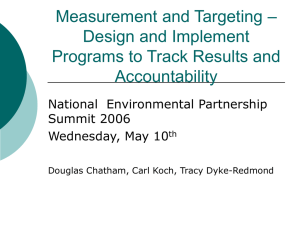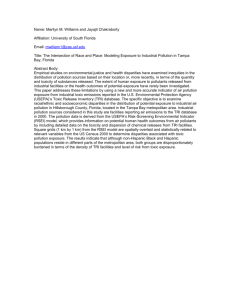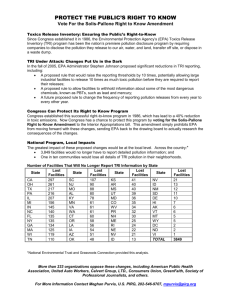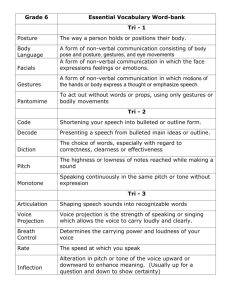45186 - P2 InfoHouse
advertisement
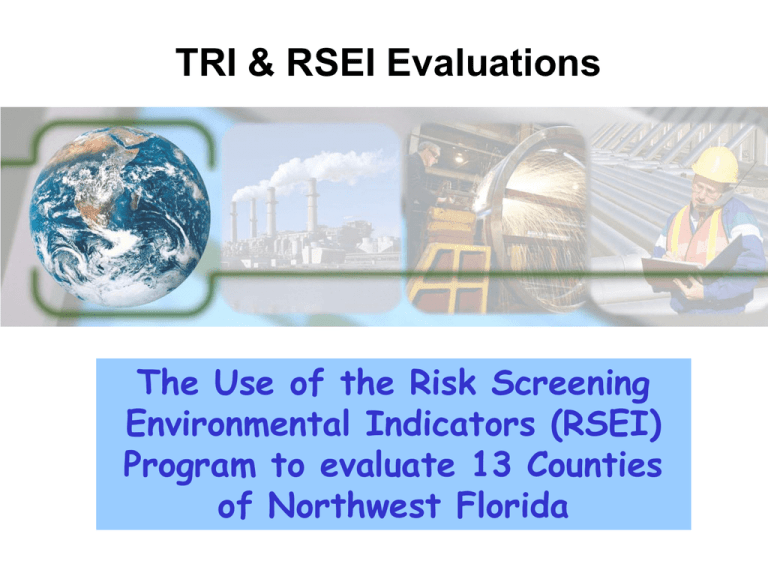
TRI & RSEI Evaluations The Use of the Risk Screening Environmental Indicators (RSEI) Program to evaluate 13 Counties of Northwest Florida What Is the Toxics Release Inventory (TRI)? The TOXICS RELEASE INVENTORY Begun in 1988, the Toxics Release Inventory contains information on releases of nearly 650 chemicals and chemical categories from industries including manufacturing, metal and coal mining, electric utilities, and commercial hazardous waste treatment, among others. http://www.epa.gov/triexplorer http://www.epa.gov/enviro http://www.scorecard.org http://www.rtk.net A-2 What Is the Risk-Screening Environmental Indicators Model? RSEI is a screening-level model for assessing potential chronic human health impacts of industrial releases of toxic chemicals: RSEI provides the following types of screening analyses: Pounds Hazard Risk-related RSEI uses TRI pounds of release data and adds toxicity, fate and transport, and an estimate of exposed population to allow new perspectives on hazard and risk. A-3 Where Do You Want Me To Start??? A. Who Reports to TRI?? B. How Does RSEI Work?? C. How is RSEI Data Processed?? D. The NW FL Example A-4 TRI REPORTING PROCESS Covered Primary SIC Code(s) or Federal facility? Ten Employees? (20,000 hours) YES NO MPOU* Section 313 Chemicals? YES STOP YES NO NO MPOU* Thresholds Exceeded? NO YES Reporting Thresholds Met; Form R/Form A Required *MPOU: Manufacture (including import), process, or otherwise use Introduction to TRI A-5 Introduction to TRI Reporting Exemptions Determining Thresholds Form R/ Form A PBT Overview COVERED SIC CODES Industrial Sector Manufacturing Metal mining Coal mining Electrical utilities Treatment, Storage, and Disposal facilities Solvent recovery services Chemical distributors Petroleum bulk terminals Introduction to TRI Primary SIC Code 20-39 10 (except 1011, 1081, and 1094) 12 (except 1241) 4911, 4931, and 4939, limited to facilities that combust coal and/or oil for the purpose of generating electricity for distribution in commerce 4953, limited to RCRA Subtitle C permitted or interim status facilities 7389, limited to facilities primarily engaged in solvent recovery services on a contract or fee basis 5169 5171 A-6 Introduction to TRI Reporting Exemptions Determining Thresholds Form R/ Form A PBT Overview THRESHOLDS TRIGGERING EPCRA SECTION 313 REPORTING A facility meeting the SIC code (or Federal facility) and employee criteria must file a TRI report for a non-PBT Section 313 chemical if the facility (40CFR§372.25): • Manufactured (including imported) more than 25,000 pounds per year, or • Processed more than 25,000 pounds per year, or • Otherwise used more than 10,000 pounds per year Threshold calculations are based on cumulative quantities per Section 313 chemical over the reporting year A-7 THRESHOLDS TRIGGERING EPCRA SECTION 313 REPORTING If a facility manufactures, processes, or otherwise uses any chemicals that are listed as persistent, bioaccumulative, and toxic (PBT), the threshold quantity is one of the following per Section 313 chemical or category per year (40CFR§372.28): Type of Chemical Reporting Threshold, by Activity Manufacture Process Otherwise use Highly persistent and bioaccumulative compounds Dioxin and dioxin-like compounds 10 pounds 10 pounds 10 pounds 0.1 grams 0.1 grams 0.1 grams Other persistent and bioaccumulative compounds (lead and lead compounds) 100 pounds 100 pounds 100 pounds A-8 Additional Resources . Additional Resources EPA Toxics Release Inventory (TRI) Home Page http://www.epa.gov/tri EPA EPCRA Hotline (800) 424-9346 EPA Envirofacts: http://www.epa.gov/enviro TRI Explorer: http://www.epa.gov/triexplorer A-9 EPA’s Risk-Screening Environmental Indicators (RSEI) What Is the Risk-Screening Environmental Indicators Model? RSEI is a screening-level model for assessing potential chronic human health impacts of industrial releases of toxic chemicals: RSEI provides the following types of screening analyses: Pounds Hazard Risk-related RSEI uses TRI pounds of release data and adds toxicity, fate and transport, and an estimate of exposed population to allow new perspectives on hazard and risk. A-11 RSEI and Risk Assessment RSEI incorporates components of risk assessment: Amount of chemical released Toxicity of the chemical Fate and transport of the chemical Route and extent of human exposure Number of people affected RSEI is not a formal risk assessment, but is useful for performance measurement, prioritization, and trend analysis because it systematically incorporates toxicity and exposure considerations in a screening-level analysis. A-12 How RSEI Works -- Calculations Risk-related results = Surrogate Dose * Toxicity Weight * Population Hazard-based results = Pounds * Toxicity Weight Pounds-based results = TRI Pounds released A-13 RSEI Model Details Inhalation (Air) surrogate dose divides U.S. and territories into 1-km x 1-km grid cells calculates air concentrations for each cell in 101 x 101 km grid around facilities uses population-specific exposure factors Ingestion (Water) surrogate dose calculates water concentrations in receiving streams up to 200 km downstream of outflow finds downstream drinking water intakes calculates fish ingestion exposure for population within 80 km of receiving stream uses population-specific exposure factors A-14 What Kinds of Questions Can RSEI Answer? What are the trends in hazard and risk associated with toxic chemical releases and other waste management activities at industrial facilities? When comparing industries, how can I rank which industry sectors are associated with relatively more risk? What is the relative contribution of specific chemicals to overall risk in a community (state, county, city), and how do I prioritize these for follow-up activities? For any given scenario, what release pathway for a particular chemical poses the greatest risk-related concerns? Also questions concerning: Tribal lands, EJ issues, important age groups (e.g., children & elderly), etc. A-15 Points to Remember RSEI PROVIDES QUICK PERSPECTIVES ON HAZARD & RISK, BUT IS ONLY THE FIRST STEP! RSEI uses facility-reported TRI data which can contain reporting errors. TRI data is limited to major industrial point sources. RSEI toxicity weights are based on chronic human toxicity associated with long-term exposure and do not address acute human toxicity or environmental toxicity. Dermal and food ingestion pathways (other than fish consumption), as well as some other indirect exposure pathways are not evaluated. A-16 Points to Remember cont. Metals and metal compounds are assumed to be released in the valence (or oxidation) state associated with the highest chronic toxicity weight. Some generic assumptions for stack heights, diameters, and exit gas velocities are used where facility-specific data are unavailable. RSEI results do not indicate whether hazard or risk from a chemical or facility is “acceptable” or “unacceptable” to a population or individual. RSEI is useful in many applications where TRI pounds have been used as a risk surrogate. A-17 Northwest Florida 2003 TRI Pounds Released County by Media 35,000,000 30,000,000 Land Water Air 20,000,000 UI 15,000,000 10,000,000 FL,GADSDEN FL,LIBERTY FL,WAKULLA FL,GULF FL,OKALOOSA FL,JACKSON FL,LEON FL,SANTA ROSA 0 FL,BAY 5,000,000 FL,ESCAMBIA TRI Pounds 25,000,000 0 FL,WAKULLA 20,000 FL,LIBERTY FL,GULF FL,GADSDEN FL,OKALOOSA FL,LEON FL,SANTA ROSA FL,JACKSON FL,BAY FL,ESCAMBIA Relative Risk Value Northwest Florida TRI Relative Risk Values 2003 County by Media 25,000 Water Air 15,000 10,000 5,000 0 UI Air Water Land GULF POWER SCHOLZ TALLAHASSEE HOPKINS STATION SPURLIN INDUSTRIES INC ARIZONA CHEMICAL AIR PRODUCTS & CHEMICALS STONE CONTAINER INT'L PAPER PENSACOLA GULF POWER LANSING GULF POWER -CRIST SOLUTIA INC. TRI Pounds Northwest Florida 2003 TRI Releases Top Ten Facilities by Media 25,000,000 20,000,000 15,000,000 10,000,000 5,000,000 0 7,000 AIR PRODUCTS & CHEMICALS INC STERLING FIBERS SANTA ROSA TALLAHASSEE HOPKINS STATION GULF POWER LANSING APAC SOUTHEAST HUNTSMAN PETROCHEMICAL GULF POWER - CRIST ALLIANCE LAUNDRY SYSTEMS STONE CONTAINER CORP INT'L PAPER PENSACOLA Relative Risk Value Northwest Florida 2003 TRI Relative Risk Values Top Ten Facilities by Media 10,000 9,000 8,000 Water Air 6,000 5,000 4,000 3,000 2,000 1,000 Northwest Florida 2003 TRI Releases Top Eight Facilities by Chemical 20,000,000 Barium compounds 18,000,000 Manganese compounds Sulfuric acid 16,000,000 Ammonia n-Butyl alcohol 14,000,000 12,000,000 Formic acid Methanol 10,000,000 Hydrochloric acid Nitrate compounds 8,000,000 6,000,000 4,000,000 GULF POWER - SCHOLZ TALLAHASSEE HOPKINS STATION AIR PRODUCTS & CHEMICALS STONE CONTAINER INT'L PAPER PENSACOLA GULF POWER - LANSING 0 GULF POWER -- CRIST 2,000,000 SOLUTIA INC. TRI Pounds Cyclohexanol Northwest Florida 2003 TRI Relative Risk Values Top Eight Facilities by Chemical 9,000 Chromium Lead 8,000 7,000 Acetaldehyde 6,000 Polycyclic aromatic compounds Mercury Manganese 5,000 Maleic anhydride 4,000 Hydrochloric acid Sulfuric acid 3,000 2,000 TALLAHASSEE HOPKINS STATION GULF POWER - LANSING APAC SOUTHEAST HUNTSMAN PETROCHEMICAL GULF POWER - CRIST ALLIANCE LAUNDRY SYSTEMS 0 STONE CONTAINER CORP 1,000 INT'L PAPER PENSACOLA Relative Risk Value Chlorine dioxide RSEI Team Contacts Gary Cole: (202) 564-8811 Richard Engler: (202) 564-8587 Robert Lee: (202) 564-8786 Cody Rice: (202) 564-8769 URL: http://www.epa.gov/oppt/rsei A-30 Region 4 CONTACT INFORMATION Ezequiel Velez, EPA Region 4 Toxics Release Inventory (TRI) Coordinator Tel. (404) 562-9191 velez.ezequiel@epa.gov Douglas Chatham, EPA Region 4 TRI Program Assistant Tel. (404) 562-9113 chatham.douglas@epa.gov U.S. EPA Region 4 61 Forsyth Street, S.W. Atlanta, GA 30303 A-31
